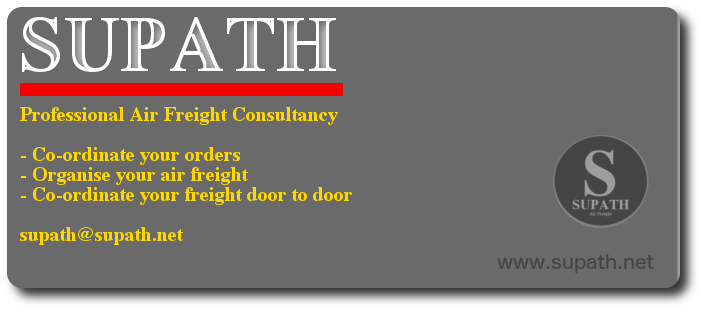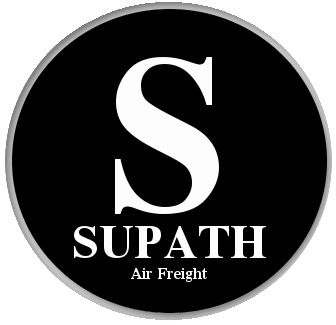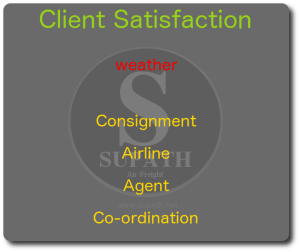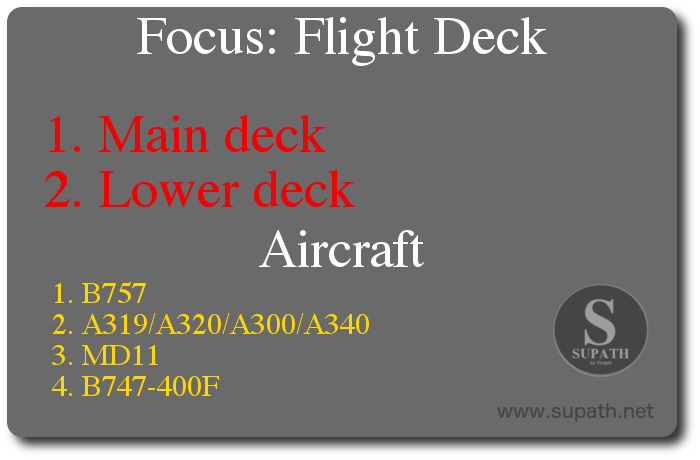Planning Airfreight Consolidation – Starting Point
This article is mainly aimed at those who are new to air freight consolidation or the line of business itself. Certain parts of the article is also meant for shippers.
The first and foremost point before you take any step in planning airfreight consolidation is to remember the most important point in freight forwarding: client satisfaction. All the other points are dependent on this one pivot. It is needless to say, this is the pivot of all businesses. This is the key factor to success in businesses and freight forwarding is no exception to this rule.
Here is a small infographic, made deliberately compact to help you focus. Later on in the article, I shall come to the small text in red. It has an important role to play in freight forwarding.
Client Satisfaction – Primary Factor in Air Freight Consolidation
Planning air freight consolidation is not a difficult task. Dedication to client satisfaction should be a point that should never go into the background. The reason is simple. The more clients you have, the more the freight you get. This will determine the success of your consolidation strategy.
Planning airfreight consolidation must take prices into consideration. It is true that price rules the market, however, good service is not a point that gets no attention. The last 15 years have shown me that there are companies that are focussed on prices alone but these have, in the course of time, lost a lot of business. Why? The logic is easy to understand. A person buying your product is paying for it and when the value is not available, the client will move to another supplier.
In the case of air freight, timing is of utmost importance. It adds value to the product the client is buying. A consignment arriving by air freight ten days after being picked up is an extremely poor service and there is no justification for that span of time
Air Freight Consolidation Pricing
Freight is consolidated for purposes of optimisation
- optimising price
- optimising timing
- optimising organisation
- optimising coordination
- Optimising destination based freight management
Since planning airfreight consolidation has price optimisation as a point, we need to see how this goal can be achieved. Getting a profit is the basis of any business. Without profit no business will survive, let alone succeed. A freight forwarder who does not go into consolidation will soon find his finances in difficulty.
The buying price for 100 Kg cannot be compared to that of a consignment of 1000 Kg. The more the weight, the more the advantage in buying. Manage your numbers by managing the weight
If you do not pay attention to the weight and volume relationship, you are going to make a big blunder one day and end up with a loss. So always keep the gross weight and volume ratio in mind, when doing your calculation
For shippers who are reading this article: When you request or demand consolidation of your freight (or in other words: you want that your consignment to go with a consolidation), you should not forget that a freight forwarder needs information regarding your freight much in advance. The earlier you advise, the better. Planning airfreight consolidation will need information regarding the dimensions and the weight of your consignment. At least the approximate values. You can always mention that the figures you’re giving are approximate values, so that the freight forwarder is prepared. Air freight is not all about weight, it about volume. You are paying for the amount of space your freight occupies. Pay attention to your packaging. External dimensions are taken into account diligently, as the space is limited. Avoid overhang! Anything above 300 cm might be considered as oversize. Avoid the risk of crossing the floor board tolerance limits by using pallets where the chocks (the feet) are covered by a plank all along the length
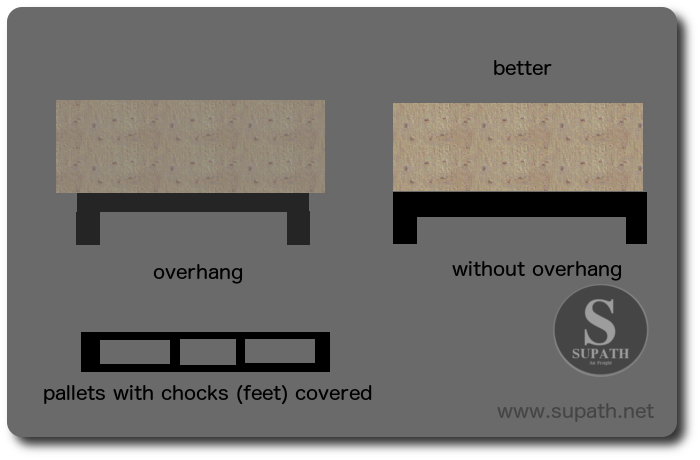
Dimension Problems In Planning Airfreight Consolidation
Do not get carried away by weights. Keep an eye on the dimensions. Overhangs can cause difficulties in consolidation! Keep your thinking clear.
Standard height limitation for lower deck consignments is 160 cm external dimension. Do not be misled by aircraft hold dimensions. Freight will be loaded into or on to ULDs by the airline (if you are using a loose consolidation). Keep in mind the limitations of the ULDs. Planning airfreight consolidation will involve these units, since freight is not loosely loaded into aircraft.
Reference : ULD Unit Loading Devices
- AKE LD3 Lightweight
- AKE LD3 – 45
- AKW LD3 – Val
- AVA LD3 – Val
- AMH 10 Ft
- AMJ 10 Ft
- PMC 10 Ft
- PLA Half Pallet
- PLW Wings
Only those with valid certification are permitted to build ULD consols (built up units). Visit Lufthansa site for detailed information on ULDs.
Main deck height limits vary from aircraft to aircraft. Long haul flights do not use B757 aircraft. Yet, I have mentioned this aircraft above, because There are several situations where your freight is not going to fly directly to the destination. It will be offloaded at the main airport and then transferred to another flight to continue the journey. This flight may be on a narrow body aircraft. Various airlines use various limits. On a B757 80cm is loadable, however Malaysian Airways used to limit it to 70 Cm. Remember, smaller freight is usually loaded by hand into the aircraft ( ATR72 for example). So keep in mind these limitations. Else your consolidation will face difficulties.
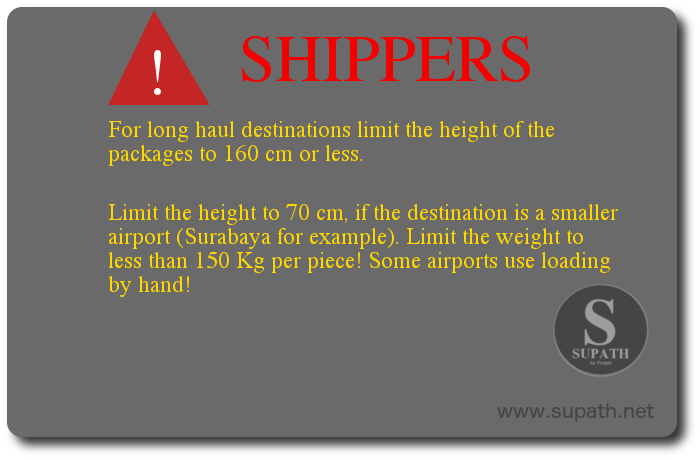
A319/320 aircraft are usually limited to 110 Cm on the lower deck. Lufthansa might allow 114 Cm. The airline will usually inform you when you book. Lufthansa will always inform you while booking. Yet, it is always better to be informed beforehand.
MD 11 aircraft can take in 244 cm in height and B747-400 can take in 295 Cm (Length and width matter, as well!!!). Certain versions of the jumbo can take a bit more. Give the airline the exact dimensions.
Large Machinery
This information is mainly for shippers and is not for consolidation purposes.In General, airlines will refuse any packaged consignment of 10 tonnes or more than that. Hence, the airline loadmaster will request an inspection of the cargo. The shipper should make a drawing available to the loadmaster.
Since the machine will be loaded on to an air freight pallet, it should be remembered that standard regulations prohibit a “metal-on-metal” transport. Provide wooden beams and at the same time keep an eye on the height.
Weight Volume Management in Planning Airfreight Consolidation
Keep a spreadsheet ready. It should have the following columns (apart from the destination and the MAWB and the shipper details)
[easytable sort=”desc,asc” ]
No. of pieces, L, W, H, Gr.Wt, CBM , Vol.Wt, Ch.Wt.
[/easytable]
- L = Length
- W = Width
- H = Height
- Gr.Wt. = Gross Weight
- CBM = Cubic Meters
- Vol. Wt = Volume Weight (cbm x 166.6666)
- Ch. Wt. = Chargeable Weight
Agents And Co-ordination in Planning Airfreight consolidation
As mentioned earlier Optimisation is the main foundation and goal of consolidation. Although the consignments are addressed to their respective consignees, all the pieces are brought under one roof : the Master AWB, which is addressed to the air freight agent at the airport of destination.
Keeping a flow of communication with this agent is very important in air freight (or in any branch of transport) . Sent a pre-alert with all the documents (in clear print). Special documents are mandatory, if included with the freight: e. g. Certificate of Origin.
If neutralised consignments (Consignee may not know the physical origin of the consignment) are included, never sent any papers from the original shipper! Please see below.
Third Party Consignments or Neutralised Consignments in airfreight consolidation
In a third-party consignment, three companies are involved.
- The manufacturer (can be OEM ) or supplier
- The exporter
- The importer
The exporter buys from the manufacturer . The supplier invoices the exporter. The transaction between the manufacturer and the exporter is of no concern of the importer. TIn most of the situations, the exporter may not even know who the original supplier is. The documents of this transaction is not to be exposed to the importer (breach of contract).
The consignment is to be neutralised by removing all documents from the piece. In certain cases the content may need to be repackaged by the exporter (shipper / consignor). Include only the documents that the shipper has handed over.
Very important: keep the airline informed and updated. The airline needs to plan the flight and weight control and capacity management is an extensive task. Booking staff, sales staff, warehouse staff, freight management staff in the handling departments all need to get information at the right time. The staff at the station of departure, airport of departure, the airport of transit and at the airport of destination need to get information so as to prepare.
Send the airline your update on time. The best is to send a spreadsheet as shown above. The earlier you send it, the better. It is usual in air freight that consignments are advised late by shippers. Pick up delays can happen. Approximate data will help. Keep it realistic. Booking ten tonnes of freight and tendering two tonnes is not fair. At times the airlines can, in such a case, increase the rate and it might be to your disadvantage.
Punctuality
Considering the cost of air freight and the fast service it demands, punctuality should never take a backseat. For a consolidation to work well the following points must be followed. This section applies to the shippers, as well
- SLI (Shipper’s Letter of Instruction) MUST be complete with ACCURATE details (number of pieces, dimensions, weight, address information of both shipper and consignee, the terms of sale . Shipper Consignee dialogue punctuality.
- SLI must reach the forwarder on time. Preferable a minimum of one day in advance. If the consignment is of a very high weight class, the forwarder is to be informed at leat two days in advance!
- Advance bookings. Forwarders usually have advance bookings (monthly bookings / allotments)
- Pick up timing! Asking a freight forwarder to pick up freight late in the afternoon is, certainly, not fair. Airlines do not have “elastic” capacity and forwarders do not have “extra” staff on standby.
- Any special requirement at the airport of destination needs to be sent to the air cargo agent at the airport of destination on time (cold storage, crane requirement etc)
- Check the airline track and trace information on time. Changes, delays etc can happen
- Keep shipper and agent informed on time. Consignee / agent may need to prepare for equipment (heavy-duty forklift, crane, cold storage, special transport etc)
Planning Airfreight Consolidation – Shippers’ Contribution
The freight forwarder and the airline are only two “processing” links in the transport chain. The functionality of these two links is dependent on the contribution by the shipper and the consignee. The role that these two parties play is not a minor one.
The airline and the freight forwarders move the freight from A to B but everything around this small process is controlled by the clients.
Known Points of Conflict in Air Freight
Packaging : Many clients are not informed about the packaging requirements. Please refer to the article on wooden packaging. Wrong packaging can, under certain circumstances, hold up a whole consolidation
Dimensions: Wrong dimensions can break up a consolidation! Extreme deviations from those originally given to the forwarder will wreck the organisation. If the freight forwarder has planned a consolidation on a Unit Load Device; say for example a PMC that can carry 10 cubic meters; and the consignment is bigger than originally advised, then the agent has a difficulty is “reorganising” his consolidation. Unit Load Devices are not free.
Terms Of Sale (Incoterms): When using FCA please write it in full: FCA, named place. Simply writing FCA is asking the freight forwarder to guess. FCA, your factory premises is as good as EXW (Ex Works).However, if it is FCA, airport of departure, the pick up charges need to be raised on the shipper and not the consignee. The freight forwarder draws up the House AWB earlier during the day. Hence, he needs to know about the invoicing. In the evening, the consolidation will be “closed” and any correction will mean revising the MAWB. That is being unfair to the freight forwarder, as he can go home only after the consolidations are all closed.
Transport Insurance: is NOT automatically covered. A written request is mandatory for the insurance cover to be done.
Dangerous Goods in Consignment: Illegal! No matter how small, no dangerous goods (as per IATA regulation) may be included in a consignment. any dangerous goods must be declared and the mandatory steps be followed. If dangerous goods are discovered in a consignment, the consolidation will have to be halted, the problem consignment will be removed and the charges will be raised on the shipper. If the piece was included in a built up unit consolidation, the airline will raise the charges for opening up the ULD on the freight forwarder, who in turn will raise the charges on the offending shipper.
Resources
In a fast-moving world it is not easy to keep track of all information. Daily tasks are many and managing an export section can be demanding. Rules keep changing, airlines keep changing rates, security rules are updated every day. Regulations in other countries undergo changes. Customs formalities change. Keeping abreast of all these can be challenging. Leave those tasks to experienced professionals. SUPATH
